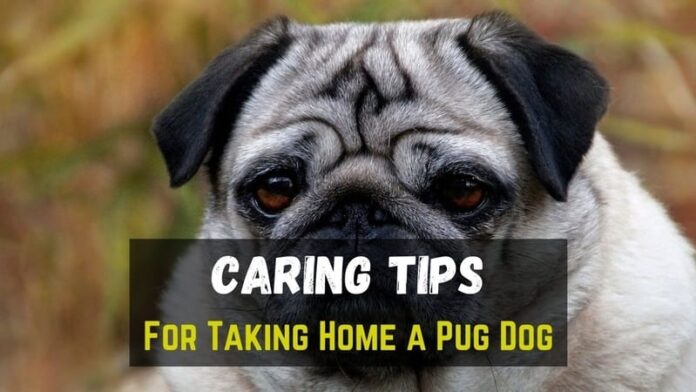Let’s start by congratulating you on your new pug! These pug dogs are one of the most affectionate breeds around. Unfortunately, they are victims of brachycephaly, which means they have respiratory disadvantages. Taking home a puppy of any breed requires certain preparations such as puppy-proofing and purchasing the right food.
Does committing to a pug require more effort on your part as a pet parent? Let’s take a look.
Start By Puppy-Proofing
Puppy-proofing is a must for puppies and even grown pugs. They are ever-curious canines and can get up to a fair amount of mischief if you aren’t looking. To save yourself the hassle of having to supervise your pug puppy 24/7, rely on puppy-proofing.
The amount of puppy-proofing will vary from each household. Some dog owners are lucky enough to have dogs that understand what they can or cannot chew. Other pet parents aren’t so lucky and end up with dogs that leave their teeth marks on everything, regardless of teething.
One thing is for sure, do not leave anything small enough to swallow where your pug can reach and anything dangerous or toxic should also be kept away from them. Some training may be required just to teach your dog what is and isn’t allowed in his new home, so make sure you give your pug plenty of toys.
It’s All About the Food
Feeding good dog food for pugs is the backbone for their development and health. You must always seek to feed your pug food that’s natural and free of artificial ingredients and preservatives. We recommend dry dog food for pugs, and there are even some breed-specific choices on the market.
Breed-specific dog foods are tailored to satisfy a pug’s unique nutritional needs. You can also look into small breed kibble as pugs also fall under this category. Fresh dog food is also a great investment for the least amount of processing and a limited ingredient diet is also suitable for this breed.
Pugs can be overeaters and are unfortunately prone to weight gain. These two factors combined increase the possibility of certain health problems, which makes it even more vital to screen what you feed them.
Use the Right Bowls
On that note, it’s also important to consider the feeding utensils. Pugs have a uniquely shaped face, which is largely flat with short snouts. They are also very avid eaters, so if the bowl is too large, they will dunk their face in and polish off the kibble in no time at all.
To discourage overeating, we suggest purchasing a slow-feeder bowl and keep the food and water bowls on the ground. A slow-feeder bowl is a bowl with raised grooves and ridges. To get to the kibble, your pug will need to eat around these raised parts which will slow down feeding time.
Remember to let your pug fully digest and process his food before attempting some exercise. Pugs are prone to bloating, so it’s a good idea to wait 30 min to an hour.
Keep them Moving
Speaking of exercise, just how much movement does a pug really need? They are quite lazy, but pugs can also be highly energetic. Regular exercise will keep your dog physically stimulated. We suggest investing in dog puzzles and stuffable chew toys to aid mental stimulation. Remember, a tired dog is a well-behaved dog.
Make sure not to overwork your dog and wait until later in the day during hot summers before taking him on his usual walk. Brachycephalic breeds do not handle the heat and overexertion well.
We would suggest 20 to 30-minute walks a day depending on how brisk it is and maybe some fetch time at home. Supplement these daily walks with some extra training and puzzle toys to challenge their minds. Most people forget that their dogs need to be stimulated mentally on top of physical exercise.
No Collars Please
When you bring a pug dog home, you have to familiarize him with not only his home environment but the outside world as well. Socialization for a developing puppy is imperative to his growth.
When you take your pug on a walk, refrain from using dog collars as the leash attachment. It’s okay to keep a collar on your pooch loosely for identification purposes, but for leashing, we suggest using a harness. Some harnesses also have a place for ID tags or have sewn-on nameplates for IDing.
The collar can restrict your pug’s airway even more than it naturally is, but a harness will disperse the pressure across your dog’s chest and back and take the strain off their trachea. In fact, harnesses are recommended by most professionals for dogs that are extra active or have limited breathing.
Regular Grooming
These adorable creatures really got the short end of the genetics stick. Not only are they prone to certain diseases and have shorter snouts, but they also have sensitive skin as well. Some pugs have neck folds that can easily develop bacteria if they aren’t regularly groomed.
Pugs can also smell if they aren’t bathed frequently, more so than some other dog breeds. Make sure you and the groomer find a shampoo that is as natural and organic as possible to not irritate your pug’s already sensitive skin.
We also recommend taking regular vet trips around once or twice a year to check on the health condition of your dog. Since they are a more fragile breed, a checkup never hurts.
Although pugs have a short coat, they are still heavy shedders. To combat shedding and to avoid hair gathering everywhere in your home, regular brushing about once or even twice a day will make a big difference.
Conclusion
Bringing a new puppy or dog home is a very exciting event. It’s important to be prepared before embarking on this new adventure, and following our above tips can promise a successful transition for both you and your pug. These endearing dogs require more care than some other breeds, but it’s all worth it when you look into their adorably large eyes and feel the strong bond you share.











